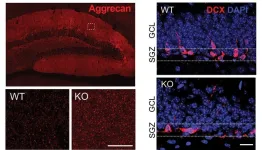(Press-News.org) Mount Sinai researchers have shed valuable light on the mechanism of a key protein that regulates the plasticity and function of the hippocampus, a key brain region involved in memory and learning, and that decreases with age in mice.
The team’s findings, published in Molecular Psychiatry, could pave the way for a better understanding of how the protein, known as tissue inhibitor of metalloproteinases 2 (TIMP2), could potentially be targeted in age-related disorders like Alzheimer’s disease to help restore affected molecular processes in the brain.
Aging is known to be the top risk factor for many neurodegenerative disorders, including Alzheimer’s disease. Previous work by Mount Sinai researchers and others found that proteins that are enriched in young blood, including TIMP2, could be harnessed to rejuvenate brain function in aged animals by affecting plasticity—or the flexibility of neural processes related to memory—in the hippocampus. Despite that important discovery, little was known about the biology of how TIMP2 regulates plasticity of the hippocampus at the molecular level.
“In our latest study, we detailed a molecular link involving this protein that ties processes of plasticity, including the generation of new neurons in adulthood, to the structural nature—or what we call the extracellular matrix—of the hippocampal microenvironment,” says Joseph Castellano, PhD, Assistant Professor of Neuroscience, and Neurology, at the Icahn School of Medicine at Mount Sinai and senior author of the paper. “TIMP2 controls these processes by changing the flexibility of the microenvironment through components of the extracellular matrix. Studying pathways that regulate the extracellular matrix could be important for designing novel therapies for diseases in which plasticity is affected.”
For their work, the team used a mutant mouse model mimicking the loss of TIMP2 levels in the blood and hippocampus that is known to occur with age. The team also created a model that allowed researchers to specifically target and delete the pool of TIMP2 expressed by neurons in the hippocampus. These models, in combination with RNA sequencing, confocal imaging, super-resolution microscopy, and behavioral studies, allowed for a detailed molecular examination of TIMP2’s regulation of plasticity.
The researchers, including first author Ana Catarina Ferreira, PhD, a postdoctoral fellow in Dr. Castellano’s group, learned that the loss of TIMP2 results in an accumulation of extracellular matrix components in the hippocampus that occurs alongside a reduction in plasticity processes, including the generation of adult-born neurons, synaptic integrity, and memory. The extracellular matrix is a network of many macromolecular components that make up the structural microenvironment around and between cells.
“We directly targeted this phenotype with an enzyme delivered to the hippocampus that affects the extracellular matrix and found that plasticity processes normally impaired in the setting of reduced TIMP2 were now restored,” notes Dr. Castellano. “This finding has important implications for fundamentally understanding how plasticity is regulated at the structural level in brain regions involved in memory.”
Overall, the findings suggest that targeting processes that regulate the extracellular matrix may be an important direction for designing approaches that improve plasticity in the brain. Dr. Castellano, whose lab is focused on characterizing factors with the potential to reverse features of brain aging, plans to explore molecules beyond TIMP2 that regulate the extracellular matrix, and is optimistic about where this research may take the field in the context of mitigating a variety of disorders associated with aging.
The study was supported by funding from the National Institutes of Health, National Institute on Aging (R01AG061382, RF1AG072300, T32AG049688).
About the Mount Sinai Health System
Mount Sinai Health System is one of the largest academic medical systems in the New York metro area, with more than 43,000 employees working across eight hospitals, more than 400 outpatient practices, more than 300 labs, a school of nursing, and a leading school of medicine and graduate education. Mount Sinai advances health for all people, everywhere, by taking on the most complex health care challenges of our time—discovering and applying new scientific learning and knowledge; developing safer, more effective treatments; educating the next generation of medical leaders and innovators; and supporting local communities by delivering high-quality care to all who need it.
Through the integration of its hospitals, labs, and schools, Mount Sinai offers comprehensive health care solutions from birth through geriatrics, leveraging innovative approaches such as artificial intelligence and informatics while keeping patients’ medical and emotional needs at the center of all treatment. The Health System includes approximately 7,400 primary and specialty care physicians; 13 joint-venture outpatient surgery centers throughout the five boroughs of New York City, Westchester, Long Island, and Florida; and more than 30 affiliated community health centers. Hospitals within the System are consistently ranked by Newsweek’s® “The World’s Best Smart Hospitals” and by U.S. News & World Report's® “Best Hospitals” and “Best Children’s Hospitals.” The Mount Sinai Hospital is on the U.S. News & World Report® “Best Hospitals” Honor Roll for 2023-2024.
###
END
University of Houston Assistant Professor of Biology and Biochemistry Quentin Vicens has been awarded a $1.2 million grant from the National Institute of General Medical Sciences to unravel the mystery of Z-RNA – an enigmatic RNA structure within our cells that plays a critical role in immune response. This work is in collaboration with the laboratory of Beat Vögeli, associate professor at the University of Colorado and co-recipient of the award.
Vicens, Vögeli and their research teams are on a mission to understand how Z-RNA forms, how often it appears in our genetic material and what it means for ...
Highlights
In a preclinical study, altering the intestinal microbiome with narrow-spectrum antibiotics affected organ damage associated with hypertension.
Results from the study will be presented at ASN Kidney Week 2023 November 1–November 5.
Philadelphia, PA (November 2, 2023) — New research in rodents indicates that altering gut microbes may affect the development of organ damage associated with hypertension. The findings will be presented at ASN Kidney Week 2023 November 1–November ...
Highlights
Investigators found that in patients with diabetes and cancer, sodium glucose cotransporter-2 inhibitors were associated with a higher risk of diabetic ketoacidosis and fracture and a lower risk of acute kidney injury and urinary tract infection compared with glucagon-like peptide 1 receptor agonists.
Results from the study will be presented at ASN Kidney Week 2023, November 1–November 5.
Philadelphia, PA (November 2, 2023) — Sodium-glucose cotransporter-2 inhibitors (SGLT2i) have heart- and kidney-related benefits for patients with and without diabetes ...
Highlights
Among individuals receiving in-center hemodialysis treatment in Washington, Oregon, and California, exposure to wildfire-related air pollution was associated with elevated risks of hospitalization and mortality.
Results from the study will be presented at ASN Kidney Week 2023 November 1–November 5.
Philadelphia, PA (November 2, 2023) — In analyses of data from western US states, increases in wildfire-related air pollution around dialysis clinics were linked to higher rates of hospitalizations and deaths among patients. The research will be presented at ASN Kidney Week 2023 ...
Highlights
A tool that provides an automated prompt to physicians increased kidney disease screening in patients with type 2 diabetes.
Results from the study will be presented at ASN Kidney Week 2023 November 1–November 5.
Philadelphia, PA (November 2, 2023) — Investigators have implemented an automated health maintenance tool created by the National Kidney Foundation into electronic medical records to prompt primary care physicians to screen for chronic kidney disease (CKD) in adult patients ...
The gene-editing technology known as CRISPR has led to revolutionary changes in agriculture, health research and more.
In research published in Nature Catalysis, scientists at Florida State University produced the first high-resolution, time-lapsed images showing magnesium ions interacting with the CRISPR-Cas9 enzyme while it cut strands of DNA, providing clear evidence that magnesium plays a role in both chemical bond breakage and near-simultaneous DNA cutting.
“If you are cutting genes, you don’t want to have only one strand of DNA broken, because the cell can repair it easily without editing. You want both strands to be broken,” said Hong ...
ITHACA, N.Y. – Online grocery carts tend to include less variety and fewer fruits and vegetables than those in a trip to a brick-and-mortar supermarket – but online shoppers are less susceptible to unhealthy impulse buys, according to a new Cornell University study.
In an analysis of nearly 2 million shopping trips, the researchers found that within a given household, Instacart baskets are more similar to each other from week to week than in-store carts, with more than twice as many overlapping items between successive trips to the same retailer.
Nutritionally, however, ...
Generative artificial intelligence tools like ChatGPT, an AI-powered language tool, and Midjourney, an AI-powered image generator, can potentially assist people with various disabilities. These tools could summarize content, compose messages or describe images. Yet the degree of this potential is an open question, since, in addition to regularly spouting inaccuracies and failing at basic reasoning, these tools can perpetuate ableist biases.
This year, seven researchers at the University of Washington conducted a three-month autoethnographic study — drawing on their own experiences as people with and without disabilities — to test AI tools’ utility for accessibility. Though ...
November 2, 2023
UMass Hydrogeologists Develop Innovative Way to Predict Saltwater Intrusion into Groundwater Using Plymouth, Mass. as Test Case
Working closely with local conservation group, researchers develop new model to predict climate-change driven saltwater intrusion that is transferable to other vulnerable coastal communities
AMHERST, Mass. – As the world warms and ice sheets melt, the ocean continually rises. The greater Boston area can expect to see between one and six feet of sea level rise by 2100, according to recent ...
By David L. Chandler
WOODS HOLE, Mass. -- Sharks differ from other fish in many ways, including an apparently remarkable ability to heal from wounds, according to reports of sharks recovering from injuries sustained in the wild. While this healing ability has not yet been documented in controlled laboratory conditions, some of the chemical compounds found in shark skin may have significant biomedical potential.
To investigate this possibility, two dermatology researchers from the Karolinska Institute in Sweden carried out research on a small shark, the spiny dogfish (Squalus acanthias) and other cartilaginous fish species at the ...






